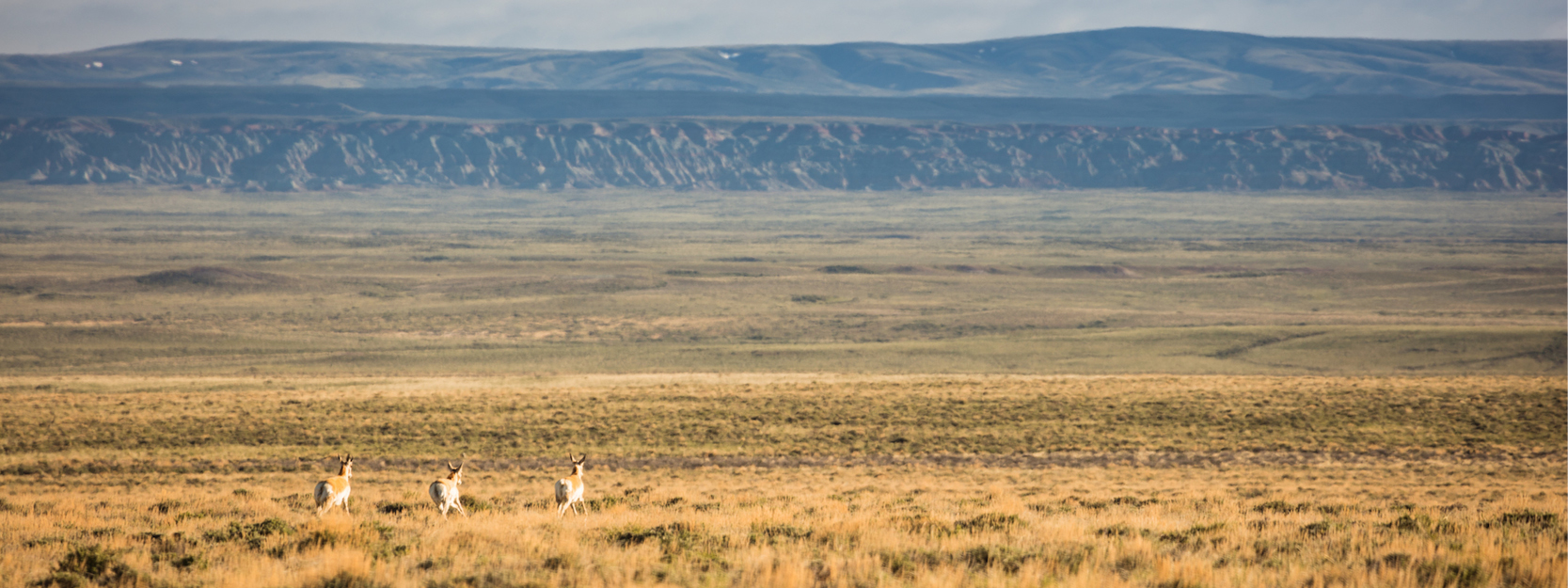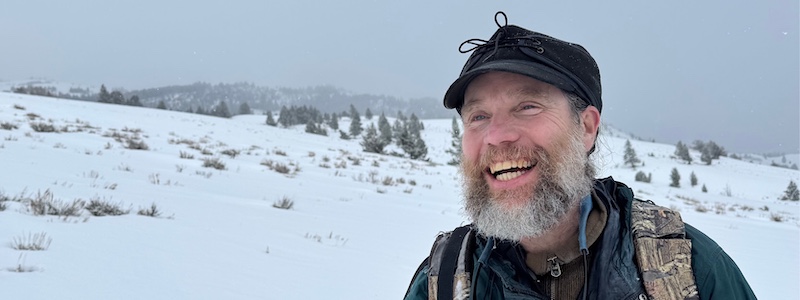
In a world where wild, open spaces are rapidly disappearing, Wyoming is unique.
We still have rugged, awe-inspiring public lands to explore. We have vast stretches of undeveloped land where mule deer, elk, and pronghorn migrate freely and where nearly half of the world’s Greater sage-grouse live, and we have rivers and streams that support world-class native trout. The Wyoming Outdoor Council works to ensure the sustainability of wildlife habitat today and far into the future.
MIGRATION
CORRIDORS

Elk, mule deer, pronghorn, and dozens of other species need intact habitat to survive. That’s why we advocate for crucial big game winter range and seasonal habitats such as migration corridors and stopover sites. Working with partners, we’re seeking long-term safeguards for the 150-mile Red Desert to Hoback mule deer migration corridor—the world’s longest. We’re also advocating for the Wyoming Game and Fish Department to designate and protect other known corridors around the state, and encouraging the governor’s office to issue an executive order halting development in the most crucial habitat.
Since September 2018, we’ve seen a surge of parcels offered in critical mule deer habitat, including in migration corridors and winter range. Many of these parcels have gone for as little as $2 per acre. Time is running out to ensure we don’t lease our most valuable habitat out from under our most vulnerable species.
We must act now to defend this world-renowned corridor and other habitat big game herds rely on for survival. The majority of Wyoming citizens do not support oil and gas leasing inside migration corridors. The fact is, if we care about the future of our mule deer herds, we should not be leasing here today.
The increasing body of science from research in Wyoming shows that mule deer stick to their migration routes more than other big game do, and that they cannot adapt their migration strategy to avoid energy infrastructure and other human disturbance.
And once migrations are disrupted they may never be restored. Once we fragment and develop stopover sites and winter range, we can’t make more of it. If we want to ensure Wyoming’s mule deer herds stay viable well into the future, we need to challenge oil and gas leasing in their most vital habitats now.
Multiple use of our public lands means identifying the highest and best uses on any given acre. It means making informed decisions about where oil and gas development should happen and where it shouldn’t. The science is clear: if we value Wyoming’s mule deer, their migration corridors should not be leased.
GREATER
SAGE-GROUSE

Wyoming is the biological and political epicenter of both the historic effort to protect the Greater Sage-grouse and its habitat, and the current effort to defend these conservation measures. With its tens of millions of acres of sagebrush habitat, Wyoming is home to almost 40 percent of the world’s Greater sage-grouse.
Several years ago, Wyoming charted a collaborative and science-based path forward—identifying sage-grouse “core areas” where development would be limited. Neighboring states largely adopted Wyoming’s model, as did the Bureau of Land Management. These actions averted listing of the bird under the Endangered Species Act.
But this presidential administration’s stated priority of “energy dominance”—which has resulted in the BLM fast-tracking leases on public lands, increased drilling in sage-grouse core habitat, and a lack of agency accountability—greatly threatens that habitat, along with the hundreds of species that rely on it. The Outdoor Council is playing a leading role to ensure conservation measures remain in place.
NATIVE TROUT

Much of our work results in sustained or better habitat for fish. From finding solutions to avert 136-gas wells from being drilled at the headwaters of the wild and scenic Hoback River, to working with anglers in Saratoga to address municipal waste in the North Platte, a blue-ribbon fishery, to efforts with Brooks Lake Lodge to clean up its antiquated sewage lagoons to help ensure we never see a repeat of the fish die-off that happened in 2008 downstream, the Outdoor Council is a leading voice for clean water and healthy fisheries.
Today we’re working to ensure proposed oil and gas development in Colorado River cutthroat trout habitat in the South Cottonwood drainage of the Wyoming Range only goes forward with rigorous safeguards.
THE LATEST FIELD NOTES, News & Action

-

TOGETHER, WE’RE GIVING SUBLETTE PRONGHORN A PATH FORWARD
For millennia, Sublette Pronghorn have traveled the same time-worn migratory pathways, moving from Wyoming’s Green River Basin to lush summer ranges as far north as the Tetons. But in just the past 150 years, their journey has faced growing threats — from population crashes and barbed wire fences to energy development and rural subdivisions. Without […] READ MORE >
-

“Pronghorn are a great avenue to amaze and inspire people.”
A conversation with Jackson naturalist Kevin Taylor, pondering pronghorn in Jackson Hole, ‘nature inheritance,’ and hope for the next generation Twice a year, Sublette Pronghorn embark on one of the longest land migrations in the lower 48 states — an epic journey stretching 165 miles from I-80 to Grand Teton National Park. Their ancient migration […] READ MORE >
-

“It’s never going to be easier to protect migration corridors than right now.”
A conversation with Bill Ames, longtime Green River resident, about coexisting with migrating pronghorn Twice a year, Sublette Pronghorn embark on one of the longest land migrations in the lower 48 states — an epic journey stretching 165 miles from I-80 to Grand Teton National Park. Their ancient migration pathways crisscross highways and meander through […] READ MORE >
COMMENts, Letters, & Other Documents

JAN. 20, 2020 | COMMENTS
Governor Mark Gordon’s draft executive order concerning the management of big game migration corridors
JAN., 2020 | MAP
2018-2019 BLM oil and gas leased acreage within the Baggs mule deer migration corridor
JAN., 2020 | MAP
2018-2019 BLM oil and gas leased acreage within the Sublette mule deer migration corridor
JAN., 2020 | MAP
2018-2019 BLM oil and gas leased acreage within the Platte Valley mule deer migration corridor
NOV. 6, 2019 | PROTEST
Wyoming BLM’s fourth quarter competitive oil and gas lease sale
JUL. 25, 2019 | COMMENTS
Supplemental Draft Environmental Impact Statement for Converse County Oil and Gas Project
FEB. 25, 2019 | LETTER
Wyoming BLM March 2019 competitive oil and natural gas lease sale
JAN. 31, 2019 | MAP
Red Desert to Hoback (“Sublette”) mule deer migration corridor overlap with BLM third quarter 2018, Supplemental February 2019, and first Quarter 2019 oil and gas lease parcels
JAN. 28, 2019 | PROTEST
Wyoming Greater sage-grouse proposed Resource Management Plan Amendments and Final Environmental Impact Statement
JAN. 19, 2019 | LETTER
Wyoming BLM February 25 to March 1, 2019 competitive oil and natural gas lease sale
DEC. 13, 2018 | COMMENTS
Wyoming BLM first quarter competitive oil and natural gas lease sale Environmental Assessment
DEC. 10, 2018 | COMMENTS
U.S. Forest Service’s proposed land management plan amendments and Draft Environmental Impact Statement
DEC. 3, 2018 | LETTER
Ensuring functionality of wildlife corridors by using the best available science to implement secretarial order 3362
NOV. 9, 2018 | LETTER
Supplemental comments on Wyoming BLM fourth quarter competitive oil and natural gas lease sale Environmental Assessment
AUG. 21, 2018 | LETTER
Request for lease deferrals in the Sublette mule deer migration corridor and in mule deer crucial winter range
AUG. 11, 2018 | LETTER
Wyoming BLM September 2018 competitive oil and natural gas lease sale
AUG. 2, 2018 | COMMENTS
Wyoming Greater sage-grouse Draft Resource Management Plan amendment and Environmental Impact Statement
MAR. 27, 2018 | COMMENTS
Wyoming BLM second quarter competitive oil and natural gas lease sale Environmental Assessment
